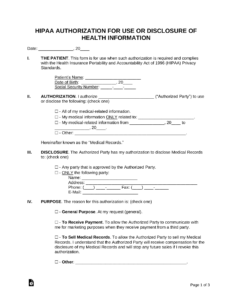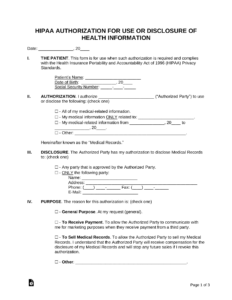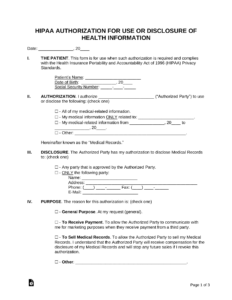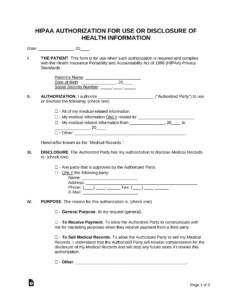Concerns about protected health information (PHI) and patient privacy are taken seriously under the Health Insurance Portability and Accountability Act (HIPAA) of 1996. Healthcare providers and covered entities must adhere to strict regulations and guidelines to safeguard PHI and comply with HIPAA privacy rules. Creating a comprehensive HIPAA privacy policy is crucial to ensure compliance and protect patient data.
Developing a HIPAA privacy policy from scratch can be a daunting task, especially for healthcare professionals with limited resources. To simplify the process, various free printable HIPAA privacy policy templates are available online. These templates provide a structured framework that can be easily customized to meet the unique requirements of healthcare organizations.
Components of a HIPAA Privacy Policy
Introduction and Purpose:
Introduce the privacy policy and explain its purpose, which is to protect the privacy of patients, ensure compliance with HIPAA regulations, and safeguard sensitive health information. Clearly state the organization’s commitment to protecting PHI.
Scope and Applicability:
Define the scope and applicability of the privacy policy by specifying to whom and what the policy applies. Clearly state whether it applies to employees, healthcare professionals, patients, or other parties. Outline the types of PHI covered under the policy.
Uses and Disclosures of PHI:
Specify how PHI will be used and disclosed for treatment, payment, and healthcare operations. Explain when and under what circumstances PHI may be released without patient authorization. Provide examples to illustrate the permissible uses and disclosures.
Patient Rights:
Outline the rights of patients related to their PHI, including the right to access, amend, and request restrictions on the use and disclosure of their PHI. Explain how patients can exercise these rights and how their requests will be handled.
Administrative Safeguards:
Detail the administrative safeguards implemented to protect PHI. Address issues such as physical security, access controls, information system security, and workforce security. Explain how the organization will ensure that its employees are aware of the privacy policy and comply with its provisions.
Physical Safeguards:
Outline the physical safeguards in place to protect PHI, such as access control, security measures, and disposal procedures for PHI. Specify how the organization will protect PHI in electronic and paper formats.
Technical Safeguards:
Describe the technical safeguards used to protect PHI, including encryption, authentication, and transmission security measures. Explain how the organization will protect PHI during transmission and storage.
Organizational Requirements:
Address organizational requirements for HIPAA compliance, such as designating a privacy officer, conducting privacy risk assessments, and developing and implementing policies and procedures for handling PHI.
Implementation and Monitoring
Implementation and Monitoring:
Describe how the organization will implement the privacy policy, including training and education for employees, regular monitoring and auditing of compliance, and handling of complaints and breaches.
Breach Notification:
Explain the organization’s procedures for notifying individuals in case of a breach of PHI. Specify the timeframe for notification, the content of the notification, and the methods used for communication.
Review and Updates:
Specify how the privacy policy will be reviewed and updated periodically to reflect changes in regulations, technology, and best practices. Define the process for making revisions to the policy and communicating these changes to affected parties.
Conclusion
Creating and implementing a comprehensive HIPAA privacy policy is essential for healthcare organizations to comply with regulations and safeguard patient data. Utilizing a free printable HIPAA privacy policy template can simplify the process and ensure that all necessary components are addressed. By following the guidance provided in the template, healthcare providers can create a robust privacy policy that protects patient privacy and demonstrates their commitment to HIPAA compliance.
Regularly reviewing and updating the privacy policy is crucial to ensure that it remains effective and aligned with evolving regulations and industry best practices. By doing so, healthcare organizations can maintain compliance, protect patient information, and build trust among their patients and stakeholders.
FAQ
What is a HIPAA privacy policy template?
A HIPAA privacy policy template is a pre-formatted document that provides a structured framework for healthcare organizations to create their own HIPAA privacy policy. It includes essential components, such as an introduction, scope, uses and disclosures of PHI, patient rights, and administrative, physical, and technical safeguards.
Why should I use a free printable HIPAA privacy policy template?
Using a free printable HIPAA privacy policy template can save time and effort in developing a comprehensive privacy policy from scratch. These templates are designed to comply with HIPAA regulations and provide a solid foundation for healthcare organizations to customize and tailor to their specific needs.
What information should I include in my HIPAA privacy policy?
Your HIPAA privacy policy should include information about the organization’s commitment to protecting PHI, the scope and applicability of the policy, uses and disclosures of PHI, patient rights, and administrative, physical, and technical safeguards. It should also address implementation, monitoring, breach notification, and review and updates.



